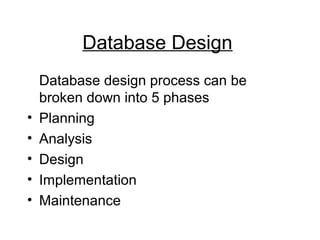The document discusses database design process which can be broken down into 5 phases - planning, analysis, design, implementation and maintenance. It describes the conceptual, logical and physical data models. The conceptual model involves entities, attributes and relationships. The logical model maps the conceptual model to tables, fields, primary and foreign keys. The physical model deals with data storage and access. The document also covers entity relationship diagrams, normalization forms and tips for effective ER diagrams.







































